Author: erkan
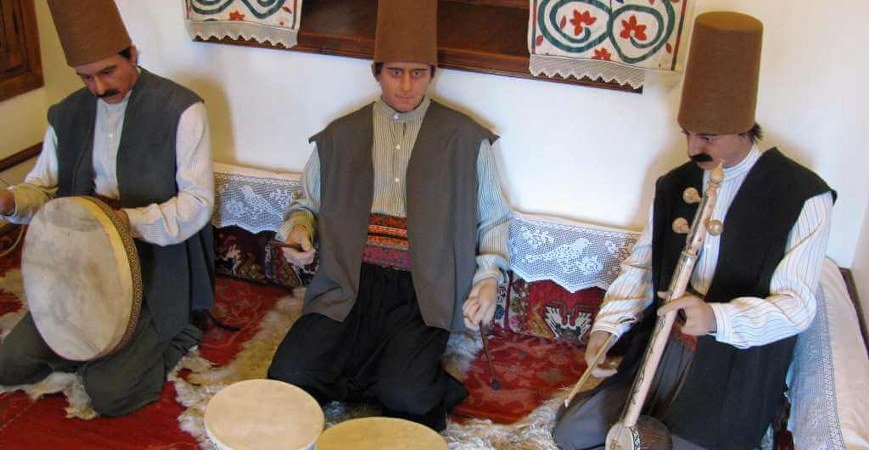
Turkey Konya Mevlana Museum – Chapter 5
Turkey Konya Mevlana Museum – Chapter 5,
The kitchen is both the place where the dargah food was prepared and also a Chilehane (novitiate) where novice dervishes took their vows before entering the Mevlevi order and lived. According to custom, during the 1001 days of their novitiate, the novices worked in the kitchen. At the end of this period, a ceremony was held at which the novice was allocated a cell, and moved to live there. Today kitchen utensils used in the Mevlana Dargah are exhibited in the kitchen.
Chelebi Apartment (Library): Adjoining the south side of the tomb is a glass windowed room where the sheiks of the Dargah used to receive guests, called the Celebi Apartment. The window which looks onto the Tomb is called the Niyaz Window or Supplicant Window. Today the Chelebi Apartment is used as the Library of the Museum and contains 6 thousand printed and manuscript books. The museum also possesses three private libraries containing books donated by Abdulbaki Golpinarli, M. Ferid Ugur, and Mehmet Onder.
Hall of Honour (Director’s Office): Adjoining the kitchen is a large hall called the Hall of Honour (Meydan-i Serif) which today is used as the Director’s Office. This hall was formerly used for conversations between the sheik of the Dargah and the dervishes. In 1867 the ceiling of this room was decorated with designs and pictures in oil paint. Besides this, there is a single storied building on the north side of the courtyard near the Chelebi Gate called the Chelebi Guest House which was originally used as accommodation for visiting dervishes.
Fountain and Seb’i Arus Pool: In the courtyard of the museum is a fountain made of sky marble, which was built by Yavuz Sultan Selim in 1512. The fountain was repaired in 1595 by Sultan Mehmed III and in 1868 by Sultan Abdulaziz. In front of the Kitchen is a six-sided marble pool which is named ‘Celebration Night’ (Seb-i Arus) because the dervishes danced beside it on the anniversaries of Mevlana’s death.
You can continue to find more details fort he Konya Mevlana Museum in Chapter 6.
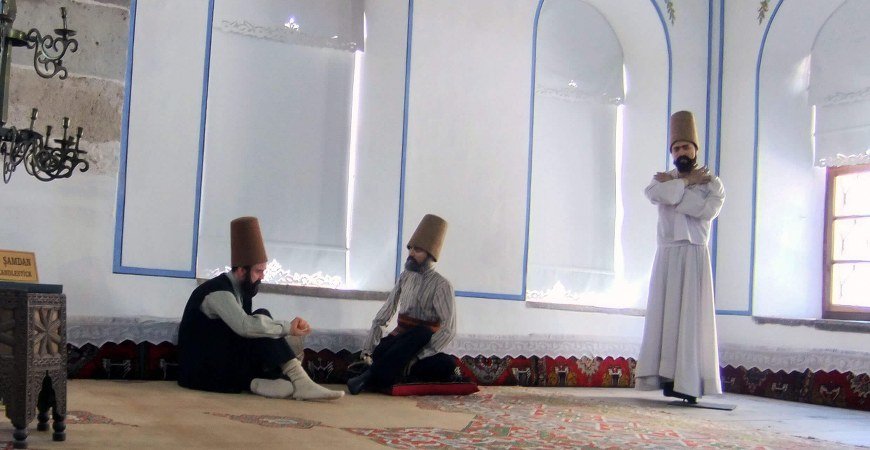
Konya Mevlana Museum in Konya Turkey – Chapter 4
Konya Mevlana Museum – Chapter 4,
Semahane: The Semahane is to the north of the Green Dome. It was built during the reign of Sultan Suleyman the Law Giver (or Magnificent) in the XVI century at the same time as the adjoining Merced and is a domed hall. The Semahane is the place where the Mevlevi dervishes do their ceremonial dance called the Sema. It contains enclosed areas both below and above, for male and female visitors, a platform where poems in praise of Mohammad or asking his intercession (Naat) are read, and a special area for musicians called the My trip Recess. Today musical instruments, lecterns, candlesticks, lamps and Milana’s clothes are exhibited in the Semahane.
Mescid: The small mosque of the Dargah, the Merced, adjoins to the west side of the Semahane. The main gate to the Merced opens onto the Dargah courtyard. The Merced has a single balconies minaret and a marble sanctuary. In showcases in the Mescid are exhibited illuminated manuscripts, kilims, and carpets.
Dervish Cells: The Dervish Cells were built in 1584 by Sultan Murad III for the Mevlevi dervishes to live in. Each of the cells, Which is to the west side of the tomb have a small dome and a chimney. The courtyard side of the cells has been closed off with a glass corridor. Today the first two have been preserved in their original state, while the others are used as the “Carpet and Cloth Pavillion”, where Seljuk-Ottoman carpets and Ottoman period cloth is woven in Istanbul, Bursa and Bilecik are exhibited.
Mevlevi Kitchen: The Dargah Kitchen is south of the dervish cells. The kitchen was enlarged during the reign of Murad III and last repaired in 1867.
You can continue to find more details fort he Konya Mevlana Museum in Chapter 5.
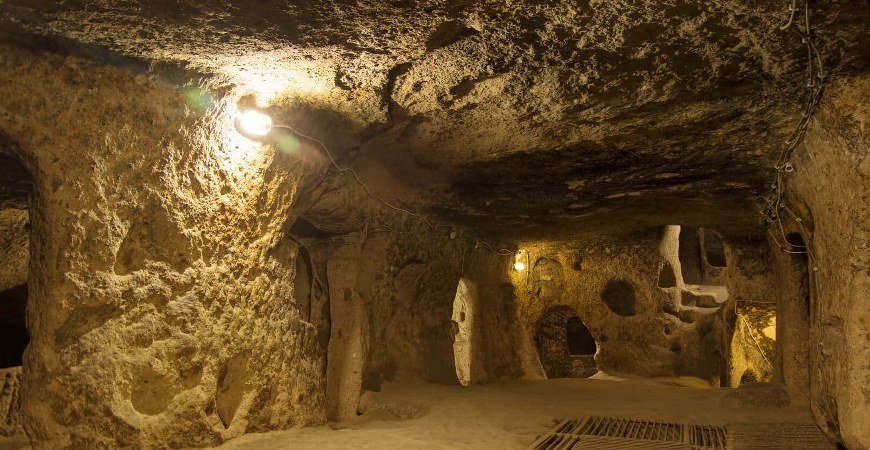
Cappadocia Underground Cities in Turkey
Cappadocia Underground Cities in Turkey,
There is a very good air circulation going away down to the lower layers. Especially the Derinkuyu Underground city being cleaned up to the last layers plays a great role in the air circulation. When we go near the air chimney on the 7th layer we can see that the chimney draws cigarette smoke down. And when we go towards the exit door on the same layer we can see that the cigarette smoke goes up continuously. The temperature in these parts is 7-8 degrees both in summer and winter. Only the places far away from air chimneys reach 13-15 degrees. One of the interesting parts is that the holes opened from the first layer of the city, have a diameter of 10 cms and a length of 3-4 meters. It is possible that these holes were made with a wooden drill having metal points. It is evident that they were used for the communication system. We can see two holes near each other at some places and single holes in other places. What kind of people were they who made the above mentioned underground cities? Detailed information about the lifestyle and the administration system of these underground people has not been obtained yet. We just know that many families used the same kitchen because we find very few kitchens in these underground cities that had lots of inhabitants. But the population of those days was more dense than today. We have come to that conclusion because the slopes of the surrounding mountains and hills were completely divided and had small gardens used for agricultural purposes. They divided and had small gardens used for agricultural purposes. The people of this region live the same way today. The slopes of said hills and mountains are used as pastures today. Of course, there is nothing that mankind cannot do. This different world existed because of oppression and disappeared and excites people’s curiosity of nowadays people and makes them wonder.
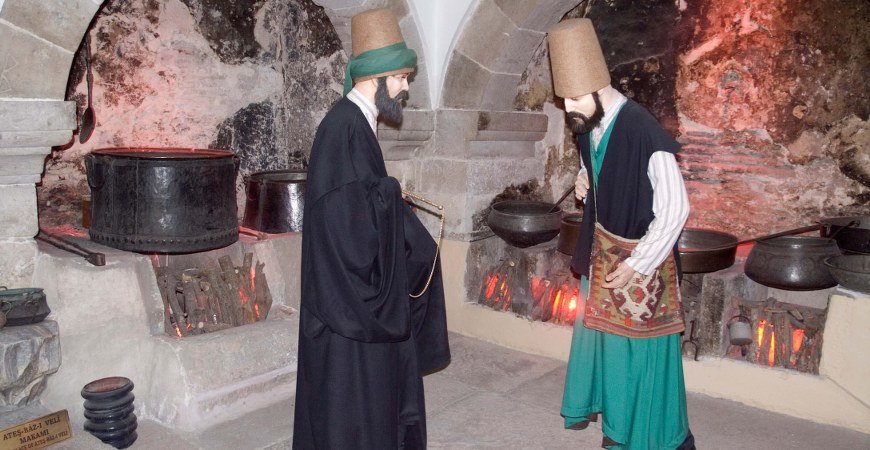
Konya Mevlana Museum – Chapter 3
Konya Mevlana Museum – Chapter 3,
The stalactite-filled dome in front of the sarcophagus of Mevlana is called the Post Dome. The oldest manuscripts of the Mesnevi (collection of poems by Mevlana), a gilded Divan-i Kebir (collection of lyric poetry), and the manuscript Divan of Sultan Veled are exhibited at the entrance to the tomb and in the cases in the center. The April Cup, which is a large bronze cauldron decorated with damascene figures and designs in gold and silver, is also exhibited here. The Imperial Sultan Abu Said Bahadir Han (1305-1335) had the April Cup made in Mosul and presented it to the north of Mevlana in 1333. One the right-hand side of the room is a silver lattice separating the sarcophagus of Mevlana from the Huzur-i Pir, called the Silver Cage. The Maras Governor, Mahmud Pasha had the lattice built by the decorator Ilyas in 1579. On it is a silver plaque on which is inscribed a 32 distich poem in Turkish by the poet Mani. Under the lattice is a silver threshold with two steps. South of the Silver Cage right under the Green Dome is the marble sarcophagi of Mevlana and his son Sultan Veled. The sarcophagi are covered with gold-embroidered covers presented by Sultan Abdulhamid II in 1894.
The wooden sarcophagus which was constructed for Mevlana at the time the tomb was built is a masterpiece of Seljuk craftsmanship. Today this sarcophagus is over the grave of Mevlana’s father Sultan’ul-Ulema. On the west side of the Green Dome are the graves of Mevlana’s wife and children, sheiks of the Mevlana Dargah, and descendants of Mevlana, and to the east, there are more graves belonging to members of Mevlana’s family, totaling 65 sarcophagi in all. All the sarcophagi are covered with richly embroidered clothes.
You can continue to find more details fort he Konya Mevlana Museum in Chapter 4.
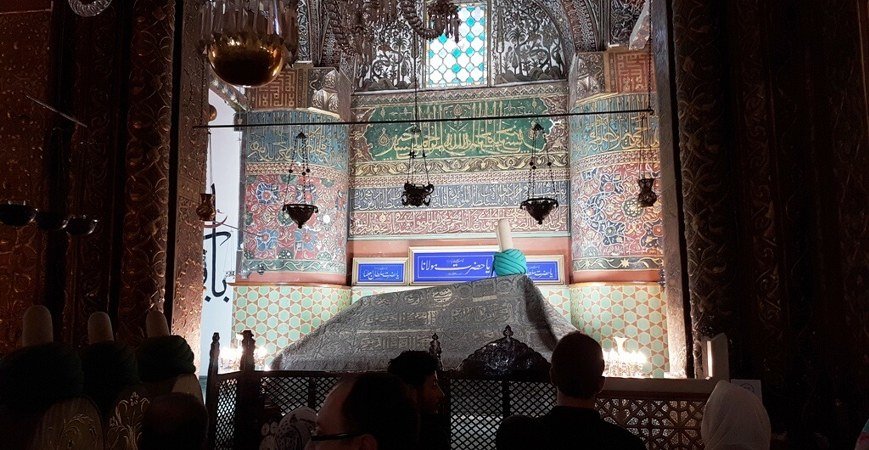
Konya Mevlana Museum – Chapter 2
Konya Mevlana Museum – Chapter 2,
On the west side of the Kulliye of the Mevlana Tomb and Dargah are the Dervish Cells, and on the other three sides are walls. On the western side, the main Dervishes Gate leads into the Mevlana Museum and Tomb. The gate to the south called “Bab-i, Hamusan” leads to the Garden of Souls (Hadikat’ul-ervah) which was once a graveyard, and the door to the north near the Celebi Apartments is called the Celebi Gate.
Entrance: The Main Gate leads into a marble courtyard with fountains for ablutions before entering the mosque. The Tomb Gate is also on this side, its two doors being decorated with Seljuk motifs.
Tilavet Room (Calligraphy Section): The Tomb gate leads into a small domed room, where the dervishes used to read the Koran. This room has now been arranged as the Calligraphy Section and examples of work by famous calligraphers of the Ottoman period in the sulus, nesih, and talk styles are exhibited. A silver door in the Tilavet Room leads to the Tomb. An inscription on the door says that it was made by the son of Sadrazam Sokullu Mehmed Pasha in 1599.
Tomb (Huzur-i Pir): The silver door leads to the Tomb chamber which is called “Huzur-i Pir”. To the right and on the opposite side of this three domed chamber is a fairly high dais on which are sarcophagi. The two dais to the right, each covered by two domes, and the Green Dome over the tomb of Mevlana is called the Kibab’ulaktab, which means the Poles Domes. The six tombs in rows of three which are on the dais under the arches which divide the Semahane or dance hall from the Mescid are called the “Horasan Soldiers.”
You can continue to find more details fort he Konya Mevlana Museum in Chapter 3.
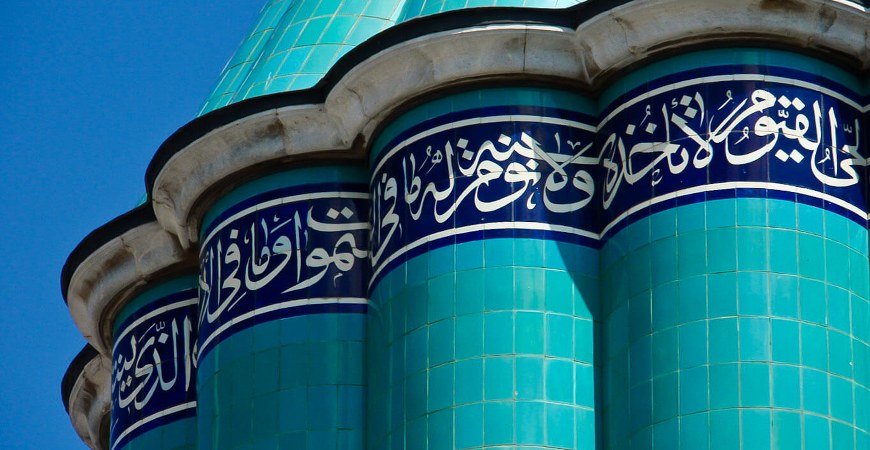
Konya Mevlana Museum – Chapter 1
Konya Mevlana Museum – Chapter 1,
The Konya Mevlana Dargah (dervish retreat) in Konya, where the tomb of the great Turkish thinker and mystic philosopher Mevlana Celaleddin is situated, was turned into a museum in 1927 and contains Objects pertaining to Mevlana and the Mevlevi order. The Mevlana Tomb and Dargah are of Seljuk and Ottoman construction. Mevlevi writings say that the site of the Tomb and Dargah was originally the private garden of the sultan in Seljuk times and later presented to Mevlana’s father Sultanul Ulema by Sultan Alaeddin Keykubad I. Sultanul Ulema who died 42 years before Mevlana was buried in this garden. When Mevlana died on December 17, 1273, his body was brought here and buried beside his father, and construction of a tomb begun. The architect Tebrizli Bedreddin built the tomb with the financial help of the wife of the Seljuk Emir Suleyman Pervane, Gurcu Hatun, Emir Alameddin Kayser and Mevlana’s son Sultan Veled. It was completed in 1274. It is thought that this first building was of cylindrical shape standing on four pillars with a conical dome. In 1396 and again during the time of the Ottoman Sultan Beyazit II repairs and additions were made and the interior decorated with painted designs.
Today the Tomb rests on arches supported by four pillars and is 25 m. in height. From the outside the body of the tomb is cylindrical in shape with 16 sections, ending at the top with stone cornices, above which is a 16 sectioned conical spire. The whole tomb including the spire is covered with turquoise colored tiles which were replaced from time to time. For this reason, it was called the Green Dome. On the side of the Dome in dark blue Sulus script are inscribed the Besmele and Ayet-ul-Kursi, and on the top of the spire is a gold moon and star symbol.
You can continue to find more details fort he Konya Mevlana Museum in Chapter 2.
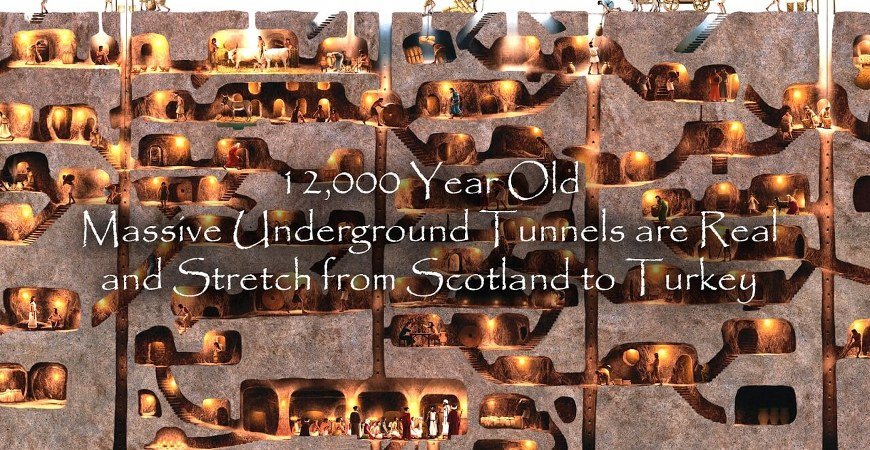
Kaymakli and Derinkuyu Underground Cities of Cappadocia
Kaymakli and Derinkuyu Underground Cities of Cappadocia,
The environment of Derinkuyu consists of a level ground but in the town center, these are a stream coming from Kaymakli-Derinkuyu direction. This stream is about 50-60 meters wide, and 8 km long and is in a completely full state. And I think that a part of the excavation poured of the underground city was poured to the bottom of the South Stream peak at the west side of Derinkuyu, and the other part was poured into the stream coming from the Kaymakli direction. If it would have been piled up at another place, these diggings would have made a great hill, but there is no hill resembling a pile of diggings in this region. On the other hand, if we suppose that the excavation was spread throughout the land, the soil of this region would have been sterile, non-productive, and sandy but there is no region having such soil. This region possesses a complete productive agricultural land. Undoubtedly mankind is able to do anything. But what forced the people of that time to leave the world’s surface and construct the Underground Cities which are so difficult to make? In general, if we consider the Underground Cities, we can see that these cities were constructed over a leveled ground or a hill’s side. Tribes felt the necessity of continuous shelters to protect themselves from all kinds of danger. The reason these tribes preferred the region of Cappadocia was because it was easy to dig this region since it consisted of tuff and soft rock. As a matter of fact, they could not make these cities with the technique of that period if the rocks were not soft. Basically, these rocks are very soft. They harden at the contact of air. If we examine carefully, we can see that there is a difference between the first layers and the last layers and that there are differences in some of the air chimneys. One can see that the upper layers and some of the air chimneys got rougher and that they were made at random and that there are no traces of drills. It is also visible that lower layers and other air chimneys are softer and even certain parts can be dug, easily they did not get much harder, the traces of drills are still very clear and the chimneys are very smooth and that some of these are round and others square. In 1910, an Englishman R. Campbell Thomson, found things such as rocks, and hand axes belonging to the Paleolithic Age in the Soganli stream 26kms. far from Derinkuyu. Since the underground cities are in this region, the first layers above of these cities belong to the Paleolithic Age? This has not been proven so far. But a church in the form of a cross was found in the 7th layer of this underground city at Derinkuyu District, and the first layers were dug later, and a missionary school and a place of Baptism was made. Thus, this is the absolute proof that Romans and Byzantines resided here After Christ. The ventilation system of the underground cities was very proper.

Istanbul Municipal Museums – Chapter 2
Istanbul Municipal Museums – Chapter 2,
They moved into the house in Sisli with Ataturk, who put aside the third floor for their use. He himself lived on the middle floor, using the room which looked onto the back garden as his bedroom. The large salon he used as a conference room. On the ground floor lived his aide de camp. During these dark days when Istanbul was under enemy occupation, Ataturk held many secret meetings with his friends in this house. He lived here until May 16, 1919, when he left for Samsun.
After Ataturk went to Anatolia and settled down in Ankara, he brought his mother and sister to live with him on Cankaya. The house in Sisli was then bought by former deputy for Erzurum Tahsin Uzel, and in 1942 Istanbul Municipality bought the house from Uzel in order to establish the Museum of Revolution.
The house which was built in 1908 and is situated on Halaskar Gazi Boulevard in Sisli, and known as Ataturk House, was repaired by the Municipality and opened as the Museum of
Revolution in 1943. The contents are arranged as follows:
1st Floor: The front room is used as a ceremonial salon and contains a large bust of Ataturk, a sketch of his hand, his identity papers and a picture of the house of his birth in Salonika. In the back room are relics of the War of Liberation, a cart loaded with ammunition, sketches, and pictures showing military maneuvers of the Great Attack and the Sakarya and Inonu Battles, Ataturk’s marshal’s uniform, his desk and its cloth.
2nd Floor: In the front room are Ataturk’s clothes, items used by him, and a radio received as a present from the United States. In the central hall are writing sets, his watch his cigarette box, his fur hat, a recording of his voice etc. In the back room are parts of his speeches, the clothes which he wore during the days of the Sivas Congress, the clothes he wore while making the Great Speech, photographs, documents, sketches etc.
3rd Floor: Photographs of the revolutions, various books are written about Ataturk, photographs taken at the time of his death, newspapers, a jar of soil from Ataturk’s Mausoleum. etc.
Istanbul – The Museum of Picture and Sculpture:
The Istanbul Museum of Picture and Sculpture was established in 1937 in the Veliaht apartment of the Dolmabahce Palace. The museum, which is administrated by the State Academy of Fine Arts, contains the works of Turkish artists and sculptors. The museum contains the works of primitive artists such as Osman Nuri, Salih Molla Aski, Ahmed Bedri, Servili Ahmed Emin, Mustafa, Fahri Kaptan, Munip, Huseyin Giritli etc. Works of the classical artists called the Second Generation, including Seker Ahmed Pasha, Osman Hamdi, Zekai Pasha, Ahmed Ziya, Suleyman Seyit etc. Works of the impressionist school, including artists such as Ibrahim Calli, Feyhaman Duran, Ali Riza, Nazmi Ziya, Namik Ismail, Avni Lifij, Ruhi Arel, and Hikmet Onat. The works of artists of the period of the Republic from various different schools, including Sami Yetik, Sevket Dag, Vecihi Bereketoglu, A. Sami Boyar, Omer Adil etc. There is a sculpture by Turkish sculptors of various periods, and a section of works by foreign artists. There are also sections for folk art and ceramics.

Municipal Museums Of Istanbul – Chapter 1
Municipal Museums Of Istanbul – Chapter 1,
Istanbul City Museum:
This museum was established in 1946 by Istanbul Municipality in the Gazanferaga Medrese at Sarachane, Exhibited in the museum are Istanbul – Beykoz porcelain and glass, bronze and copper bowls made in Istanbul, medrese benches, writing sets, Karagoz figures, figures and pictures from the old Istanbul markets, signs, books, a picture of Fatih, the first piano to come to Istanbul, and various other Objects of culture and art.
Reformation Museum:
In 1969 the Cadir House in Yildiz Park in Istanbul was reopened as a museum exhibiting objects and documents from the Ottoman Reformation period of 1839. There is the Reformation Edict, Reformation medals and medallions, oil paintings of the sultan of the time, the Grand Vizier and other men of the state, Reformation fees, and documents and newspapers from the Reformation period.
Tevfik Fikret House Museum:
Tevfik Fikret was a poet of the Servet-i Funun school of literature who died in 1915. Istanbul Municipality bought the house which Tevfik Fikret had built at Rumen Fortress in 1906, and was called Asiyan, and in 1945 it was opened to the public as the Tevfik Fikret Asiyani New Literature Museum. In the basement of the three-story house is a dining room, kitchen, pantry, and washroom. On the first floor are a large salon, three rooms, and a hall. On the third floor are bedrooms and Tevfik Fikret’s study. The museum contains objects used by Tevfik Fikret, pictures, photographs, and documents, information and mementos of the New Literature.
Istanbul Sisli Ataturk Museum (Museum of Revolution):
On November 13, 1918, Ataturk left the Syrian Front and came to Istanbul where he moved into a suite at the Perapalas Hotel. After a few days he left the hotel and stayed in the house of his close friend Salih Fansa in Beyoglu until he rented the three story house of Madam Kasabyan in Sisli and moved in there. At that time his mother Subeyde Hanim and his sister Makbule were living in a house in the district of Akaretler in Besiktas.
You can continue to find more details about Municipal Museums Of Istanbul in Chapter 2

Underground Cities And People in Cappadocia Turkey
Underground Cities And People in Cappadocia Turkey,
Underground cities were first in attracting the attention and tiring the minds of the visitors coming to Cappadocia which possesses the historical and natural beauties made up by nature, history and human beings, that cannot be seen in any part of the world. I mentioned in the previous pages that there are 36 underground cities in this region. I wonder if the people of another world, or the underground people that do not know the world’s surface, made Cappadocia in a form of an ant’s nest by digging these underground cities, which I believe will increase with further investigations, to their forms of today. Digging all these underground cities and drawing out the excavation to another place is not really an easy job. It must be very difficult to achieve these with the technique of those days. Elimination was only done by oil lamps. And undoubtfully this illuminating system was inadequate in such places. The most suitable procedure of digging that can be right of these underground cities is first at big digging air chimneys 70-80 meters deep. making the underground cities by digging towards the sides after reaching greater and drawing up the excavation by pulleys through the air chimneys opened before. This is a logical thought because if they had not opened air chimneys they would not have been able to work and make these excavations. When searching the construction of the underground cities the following question comes up in our minds. Where and how did these bubbles disappear? The answer mound be as follows: You will notice Cappadocia is at a steep and broken location having a lot of valleys. The underground cities around Derinkuyu are generally small. But the biggest underground city in the region of Cappadocia is Derinkuyu.
The rubbles of the underground cities of the surroundings were poured into suitable streams and disappeared within time as a result of erosion.